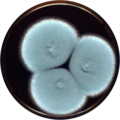| Aspergillus marvanovae | |
|---|---|
| Scientific classification | |
| Kingdom: | Fungi |
| Division: | Ascomycota |
| Class: | Eurotiomycetes |
| Order: | Eurotiales |
| Family: | Aspergillaceae |
| Genus: | Aspergillus |
| Species: | A. marvanovae |
| Binomial name | |
| Aspergillus marvanovae Hubka, S.W. Peterson, Frisvad & M. Kolařík (2013) [1] | |
| Type strain | |
| CCM 8003 [2] | |
Aspergillus marvanovae is a species of fungus in the genus Aspergillus which has been isolated from water with high boracic acid anions from the Dukovany nuclear power station in the Czech Republic. [1] [2] [3] It is from the Fumigati section. [4] Several fungi from this section produce heat-resistant ascospores, and the isolates from this section are frequently obtained from locations where natural fires have previously occurred. [5] The species was first described in 2014. [4] Aspergillus marvanovae produces apolar indoloterpenes. [6]

